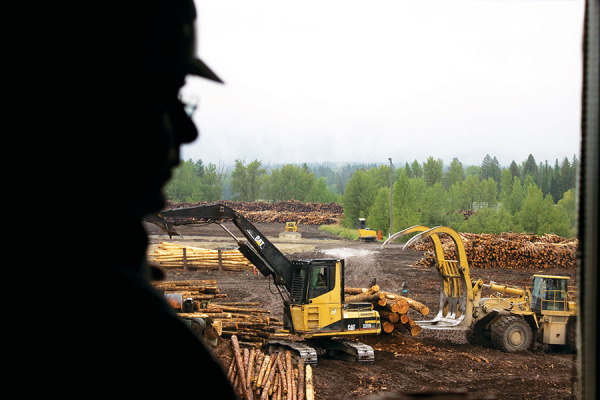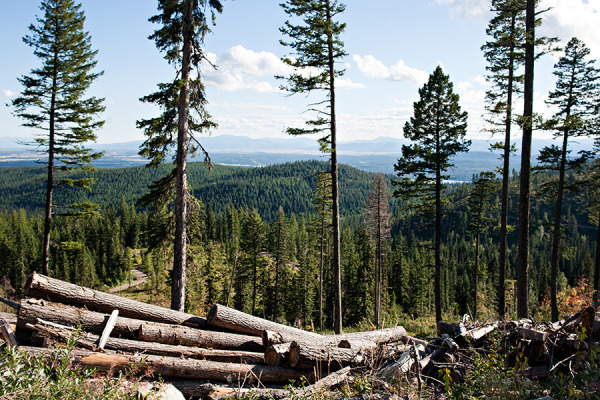At the midway point of the 20th century, the wood products industry developed into one of the bright signs in Montana’s economy, especially in the forested western section of the state. While agriculture and railroads laid off employees here, sawmills and other wood product facilities ballooned, with nearly 4,000 new jobs added in the industry from 1950 to 1970. Total personal income grew 93 percent in the seven western counties, compared to the state average of 52 percent.
Quite simply, the proliferation of the timber industry transformed the quiet economies and communities in Flathead and Lincoln counties, among other places situated in the sylvan Rocky Mountain landscape.
The growth of Montana’s logging industry correlated with a large increase in timber cutting on national forestlands, which encompass 16.89 million acres across the state, or 18 percent. By the 1970s, logging outfits, which were largely unregulated and unrestrained, were venturing further into the wild, clearcutting their way to historic profits and digging new roads to treasured locations.
It was around this time that environmental concerns spiked over impacts on wildlife and habitat, and questions were raised over the long-term effects that faced western Montana’s rich outdoors. A newfound public sentiment surfaced in favor of protecting other uses on national forests besides logging. Congress agreed and in 1970 passed the National Environmental Policy Act, which noted that the U.S. Forest Service’s forest management program was out of balance.
The passage of NEPA represented a turning point for the nation’s forestlands, and it cast a large shadow over the timber industry.
Two years later, in the spring of 1972, a researcher at the University of Montana’s Bureau of Business and Economy Research crafted a “special report” studying the wood products industry in the state.
Maxine C. Johnson’s comprehensive analysis was the first of its kind and looked at industry data and employment figures, spelling out exactly just how important the wood products industry was to the state’s economy. Johnson’s report also acknowledged a lingering sentiment that was gaining respect and widespread attention, and that could have major impacts on the industry.
“Montana also has environmental problems,” Johnson wrote in the 1972 report. “A good many Montanans recognize this; they place a high value on Montana’s outdoor beauty, its uncrowded living, and its relative freedom from some of the problems facing more industrialized areas. They are anxious to preserve these tremendous assets … They also see existing Montana industry creating environmental hazards.”
Describing this newfound sense of awareness, Johnson added a simple yet profound statement that harkened back to earlier sagas in Montana’s mining history, when an important economic industry dependent on natural resources threatened the common good.
“Here, as everyone knows,” Johnson wrote, “Montana runs headlong into the environmental dilemma.”

Johnson’s report presaged the decades to come and her “environmental dilemma” statement rings true today, as the state’s timber industry remains at loggerheads with critics opposed to harvesting forestlands they consider sensitive.
In the last 40 years, Montana’s timber industry has downsized considerably. Lumber production across the state, meaning the trees that went through sawmills and other facilities, has dropped from a record high of 1.6 billion board feet annually in 1986 to nearly 600 million last year. The number of sawmills across the state, from small operations to large facilities, has shrunk from 150 facilities to barely 30. The industry employment dropped from 10,695 workers in 1994 to barely 7,000 a year ago. The amount of timber harvested, meaning trees taken down from the forest, dropped from 1 billion board feet 30 years ago to less than 365 million last year.
What happened?
There are various reasons, including economic recessions and volatile housing markets. The economic crises of the early 1980s and 1990s delivered sizeable hits to the industry, as the primary driver in timber harvesting — new homes being built — dropped considerably and other markets, including Canada, made noticeable gains. The most recent economic recession, which was the worst since the Great Depression, similarly devastated the timber industry, as the number of new housing starts was cut in half from 2009 to 2010.
The housing market did not make sizeable gains until 2012-13. More than 900,000 new homes were built last year. This year’s housing starts are already over 1.1 million, and the price of logs is the highest in eight years.
Yet last month, F.H. Stoltze Land & Lumber Co. in Columbia Falls, the oldest family owned sawmill in Montana, announced cutbacks in production and layoffs despite a rebounding economy and favorable market for logs. Company officials cited the ongoing lack of available log supply and blamed environmental groups that persistently sued over timber sales and halted harvests across western Montana.
“The really disappointing part is we finally have a good lumber market and we’re surrounded by a sea of timber that needs to be managed,” Chuck Roady, general manager at Stoltze, said after the announcement.
The latest curtailment at Stoltze reignited a public tug-of-war over timber supply and wildlife habitat, a battle that has been ongoing over the last 40 years.
Indeed, the rise of environmental awareness has had a large impact on the industry, as protections have increased for embattled species and habitat while a greater emphasis has been placed on preserving public lands from industrialization.
But what are the impacts of a dwindling timber industry?
“Some people would say it swung like a pendulum, from one extreme to another,” said Todd Morgan, director of Forest Industry Research at the BBER at UM, working in the same role as Maxine C. Johnson 40 years later.
“What we have now is a lot of landscape that’s being managed like wilderness because of a combination of reasons. Some of it has to do with the budget Congress is allocating to the Forest Service. Some is because the Forest Service’s budget is spent on fighting fires instead of restoration and management. Some has to do with appeals and litigation. And there’s only so many people working in the Forest Service.”
Standing on the sidelines as a researcher, Morgan sees a declining industry with an uncertain fate. He has studied similar situations facing other western states, such as Colorado, New Mexico and Arizona, and seen how the timber industry in those regions have suffered, and even vanished. These states have an even higher percentage of federally owned lands, and they were hit hard during the 1990s, particularly after the Mexican Spotted Owl was listed as a threatened species under the ESA in 1990.
“They were very hard hit as the national forest timber management program went away and a lot less land and timber became available,” Morgan said. “That really impacted their industry, and now they have fire hazard issues and are trying to rebuild an industry that essentially went away. That can give you an idea of where Montana could be heading.”
Morgan agrees that timber supply is hurting sawmills. Pointing to historic data, Morgan says lumber production is approaching a threshold where even more facilities might have to close in the coming years if something doesn’t change.
“The housing starts are not coming up incredibly fast and they’re slower than predicted. A lot has to do with things that happened during recession,” Morgan said. “But, what we’re not seeing in Montana, is a strong response to improved markets. That, in my opinion, has to do with timber supply.”
Lumber production is now barely 600 million board feet, half of what it was 10 years ago. Harvest levels are similarly down, with 364 million board feet taken in Montana in 2013.
According to Morgan’s data, more timber dies each year across the state than is harvested. The latest data gathered by the BBER shows the average annual growth of timber in Montana was 280,366 cubic feet (mcf) in 2012. The annual harvest was 100,000 mcf. The annual mortality, meaning the amount of trees that died due to bug kill or fires, was 542,527 mcf, according to the BBER.
“It’s not like we’re out of timber,” Morgan said.
Beetle kill is the large reason for high mortality in Montana’s forests, particularly among ponderosa pine and lodgepole stands, which cover western Montana.
Combining high mortality and low harvests, Montana’s timber industry is faced with a challenging situation in terms of stability, according to Morgan. The current trend appears to be mirroring states like Arizona and New Mexico, where massive declines occurred in the timber industries.
“We are moving in that direction. I don’t think it’s a good direction for us if we want to keep our forests healthy and if we want to have forests that are good for recreation,” Morgan said. “It will be more difficult to maintain and manage forests if we don’t have an industry to do it.”

The Flathead National Forest in fiscal year 2015 will sell roughly 32 million board feet of timber, according to agency officials. The recent average of saw timber output has been 22-23 million board feet.
There are currently three active lawsuits involving timber sales in the Flathead National Forest and two timber sales up for bid. The Flathead National Forest is currently developing a new forest plan, which will have far-reaching impacts over the next 30 years. Part of that work will look at timber sales.
The original forest plan, developed in 1986, called for 100 million board feet annually to be harvested in the Flathead. But amendments were made to those sustainable output figures after heavy litigation brought scrutiny to those harvest quota, citing significant dangers to grizzly bears and their habitats. In the mid-‘90s the threshold was cut to 50 million board feet. Now the Forest Service aims to sell an average of 25 to 30 million board feet annually.
The persistent litigation of timber sales, which can stall a project for three to five years, has both timber executives and forest managers concerned.
“That’s a huge concern for us as an agency,” said Rob Carlin, planning staff officer for the Flathead National Forest. “Our mission is to manage vegetation in a variety of ways. If we lose the biggest tool to do that, and the biggest tool is timber harvest, we don’t have other tools to treat the forests and vegetation except fire.”
Fuel reduction is a big concern and recent large wildfire seasons are helping change the public sentiment about managing forestlands, according to Jay O’Laughlin, a timber policy expert and longtime professor at the University of Idaho.
“People are recognizing that there’s so much fuel out there in the forest that it’s creating wildfires that never existed before. The wildfires are bigger and more intense than they’ve ever been before throughout the interior west,” he said. “Part of it is climate change … But there’s also a lot more fuel out there.”
O’Laughlin is optimistic that Montana’s timber industry will make gains in the coming years, though it will take policy changes that allow sawmills to work at higher production, he said.
“I see things coming back,” he said. “It needs to, otherwise how will we manage the forests?”
Correction: The article previously incorrectly stated the Northern Spotted Owl was listed as a threatened species in New Mexico and Arizona in the 1990s; it should have stated the Mexican Spotted Owl.
